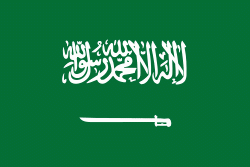'Asir Province ('Asir Region)
The capital of the ʿAsir Region is Abha. Other towns include Khamis Mushait, Bisha and Bareq. The regional governor is Turki bin Talal bin Abdul Aziz Al Saud (appointed 27 December 2018), a son of Prince Talal bin Abdulaziz Al Saud. He replaced his cousin, Faisal bin Khalid bin Abdulaziz Al Saud, on the same day.
The ʿAsir Region is situated on a high plateau that receives more rainfall than the rest of the country and contains the country's highest peaks, which rise to almost 3000 m at Jabal Sawda near Abha. Though data is exceedingly sparse and unreliable, the average annual rainfall in the highlands probably ranges from 300 to 500 mm. It falls in two rainy seasons, the chief one being in March and April, with some rain in the summer. Temperatures are very extreme, with diurnal temperature ranges in the highlands the greatest in the world. It is common for afternoon temperatures to be over 30 C, yet mornings can be extremely frosty and fog can cut visibility to near zero percent. As a result, there is much more natural vegetation in ʿAsir than in any other part of Saudi Arabia, with sheltered areas even containing areas of dense coniferous forests, though more exposed ridges still are very dry.
ʿAsir is home to many farmers who chiefly grow wheat and fruit crops. Irrigation has greatly expanded production in modern times.
Asir National Park was established in 1981, and extends from the Red Sea coast through the western foothills to the Asir escarpment.
Map - 'Asir Province ('Asir Region)
Map
Country - Saudi_Arabia
 |
 |
| Flag of Saudi Arabia | |
Pre-Islamic Arabia, the territory that constitutes modern-day Saudi Arabia, was the site of several ancient cultures and civilizations; the prehistory of Saudi Arabia shows some of the earliest traces of human activity in the world. The world's second-largest religion, Islam, emerged in what is now Saudi Arabia. In the early 7th century, the Islamic prophet Muhammad united the population of Arabian Peninsula and created a single Islamic religious polity. Following his death in 632, his followers rapidly expanded the territory under Muslim rule beyond Arabia, conquering huge and unprecedented swathes of territory (from the Iberian Peninsula in the west to parts of Central and South Asia in the east) in a matter of decades. Arab dynasties originating from modern-day Saudi Arabia founded the Rashidun (632–661), Umayyad (661–750), Abbasid (750–1517), and Fatimid (909–1171) caliphates, as well as numerous other dynasties in Asia, Africa, and Europe.
Currency / Language
| ISO | Currency | Symbol | Significant figures |
|---|---|---|---|
| SAR | Saudi riyal | رس | 2 |
| ISO | Language |
|---|---|
| AR | Arabic language |















